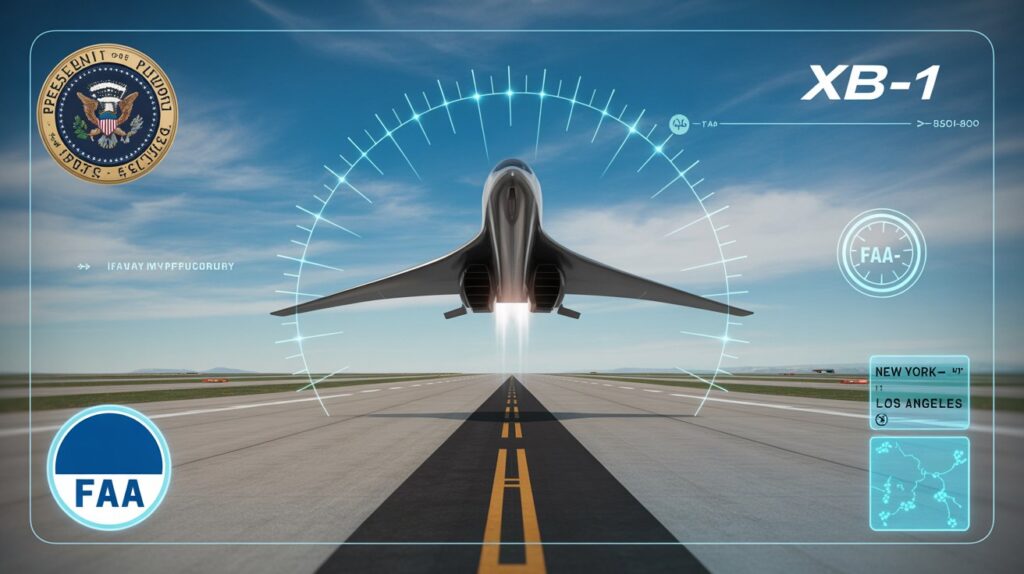
TL;DR:
- President Trump has signed an executive order lifting the 52-year ban on overland supersonic flights in the U.S.
- The FAA is now directed to develop noise-based standards for next-gen aircraft.
- This move aligns with recent bipartisan legislative efforts and could accelerate commercial supersonic innovation.
- Boom Supersonic and other aerospace startups stand to benefit, with ongoing testing already underway.
- Additional executive orders aim to fast-track drone and electric vertical takeoff vehicle (eVTOL) development.
Supersonic Flight Ban Lifted: A Regulatory Breakthrough
In a landmark aviation policy shift, President Donald Trump signed an executive order on Friday directing the Federal Aviation Administration (FAA) to lift the decades-old ban on commercial supersonic flight over U.S. soil. The decision comes just weeks after a bipartisan coalition in Congress introduced legislation advocating for the same outcome.
The order mandates that the FAA finalize noise-based certification standards, replacing the 1973-era regulation that prohibited overland supersonic travel due to sonic booms. Under the new framework, aircraft can break the sound barrier domestically — as long as the sonic boom doesn’t reach the ground audibly.
“The reality is that Americans should be able to fly from New York to LA in under four hours,” said Michael Kratsios, Director of the White House Office of Science and Technology Policy.
Supersonic Travel & U.S. Aviation Policy
| Metric | Value | Source |
| Ban on overland supersonic flight | 52 years (since 1973) | FAA |
| Time saved NY-LA using supersonic jets | ~3 hours | Boom Supersonic |
| Boom XB-1 test flight date | January 2025 | TechCrunch |
| Sonic boom threshold under new rules | Non-audible at ground level | Federal Register |
Boom Supersonic Poised to Capitalize
The decision opens doors for commercial innovators like Boom Supersonic, which has been developing the Overture airliner and already tested its XB-1 demonstrator jet earlier this year.
Boom CEO Blake Scholl reacted enthusiastically to Friday’s development, responding to press inquiries with a celebratory “Booooom!” He added:
“The sound barrier was never physical — it was regulatory. With supersonic legalized, the return of supersonic passenger air travel is just a matter of time.”
Boom’s XB-1 is the first privately developed civil aircraft to break the sound barrier over the continental United States. The company plans to begin commercial service by 2029, with potential routes cutting travel time from coast to coast by more than half.
Legislative Momentum Aligns with White House Policy
Trump’s executive order is not a unilateral pivot—it aligns closely with the Supersonic Flight Modernization Act, a bipartisan bill introduced in May. That legislation called on the FAA to update its outdated acoustic standards and enable domestic supersonic operations.
Although the FAA has been reviewing noise regulations since 2020, progress has been slow due to environmental and technical complexities. Friday’s executive directive accelerates that timeline, requiring a draft regulatory framework within 120 days.
Noise-Based Certification: The New Supersonic Metric
Under the current policy, the FAA prohibits supersonic travel over land primarily because of the disruptive nature of sonic booms. However, the new certification model will focus on how much of that boom, if any, is heard at ground level.
Companies like Boom are developing low-boom or “quiet supersonic” technologies that shape shockwaves to reduce or eliminate audible disruption. NASA’s X-59 QueSST project has also been instrumental in testing boom suppression.
This regulatory transition mirrors what the FAA did with drones—shifting from blanket bans to performance-based rules—allowing innovation to proceed while managing risk.
Future-of-Flight Agenda: More Than Just Supersonics
The supersonic directive is just one piece of a larger package. President Trump signed two additional orders Friday aimed at accelerating the future of aerial mobility:
- Drone Commercialization Order: Directs the Department of Transportation to streamline certification and flight permissions for unmanned aerial vehicles (UAVs) used in delivery, agriculture, and logistics.
- eVTOL Development Order: Prioritizes federal support for the development and safe integration of electric vertical takeoff and landing aircraft into U.S. airspace.
These steps come as tech companies like Joby Aviation, Archer, and Beta Technologies push forward with air taxi services and urban mobility systems.
Industry Reactions: Support from Startups and Aerospace Giants
Boom isn’t the only company celebrating. Aerospace firms large and small view this as a regulatory green light to pour investment into next-generation aviation.
“Today’s announcement marks a turning point in U.S. aerospace leadership,” said aerospace policy analyst Jordan Lehrman of Skyrise Ventures. “With noise-based rules, the U.S. finally gives innovators the flexibility they need to leap forward.”
International rivals like Japan and the EU have also been studying supersonic travel policy. Now, the U.S. may have a head start in developing both domestic routes and next-gen aircraft platforms.
What’s Next: Noise Trials and Industry Scrutiny
The FAA now faces the challenge of setting technical noise thresholds for overland supersonic flight. These standards will be closely scrutinized by stakeholders ranging from airlines and manufacturers to environmental groups.
Aircraft developers will need to undergo rigorous testing, likely including flight trials over unpopulated areas, to ensure compliance. The earliest commercial approvals are not expected before 2027, but the policy groundwork is now in place.
Conclusion: Supersonic Travel Is Back on the Map
Trump’s executive order to lift the supersonic flight ban signals a major shift in U.S. aviation policy. With bipartisan legislative backing, startup enthusiasm, and regulatory direction from the FAA, the era of ultra-fast domestic air travel may soon be a reality.
Though public acceptance, pricing models, and environmental concerns remain open questions, the path is now clear for the aerospace sector to reimagine air mobility in the 21st century.



